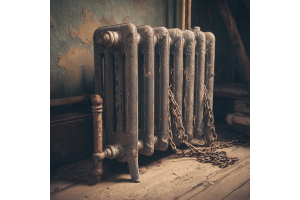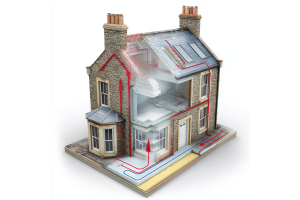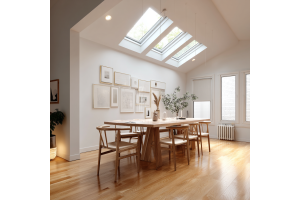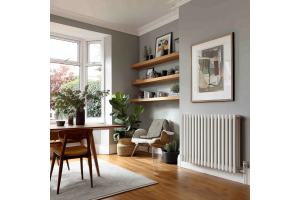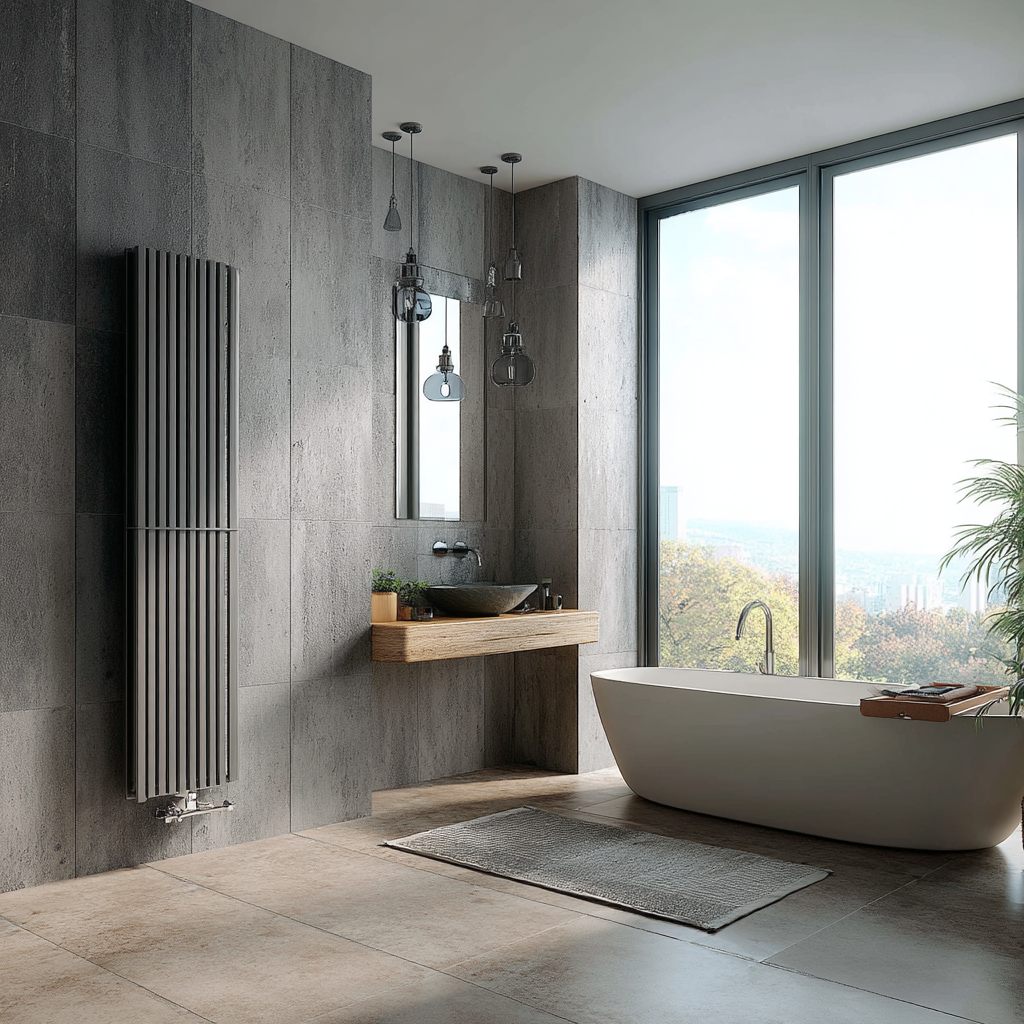
Industrial interior design has surged in popularity thanks to its raw textures, minimalist elements, and vintage-meets-modern aesthetic. Whether you're revamping a loft conversion, a new-build with urban vibes, or simply want to infuse your home with a more edgy, factory-style appeal, your choice of radiator plays a vital role in completing the look.
At Geyser UK, we know that heating shouldn’t just be functional—it should be part of your style story. In this guide, we’ll explore how to choose radiators that perfectly complement modern industrial interiors, covering style, materials, finishes, placement, and smart design choices.
What Defines an Industrial Interior?
The industrial interior design style has its roots in the conversion of old factories and warehouses into modern living spaces. Born from a blend of utility and beauty, it embraces the character of aged materials, structural honesty, and urban minimalism. To successfully incorporate radiators that align with this aesthetic, it’s important to understand what defines industrial design.
Here’s a comprehensive breakdown of the key elements:
1. Exposed Architectural Features
Industrial interiors are all about celebrating raw structure rather than hiding it. This includes:
-
Exposed brick walls: Adds warmth and texture with a vintage urban vibe.
-
Visible ceiling beams: Often in timber or steel, showcasing the building's bones.
-
Open ductwork and piping: Gives a factory-like appearance and enhances visual interest.
-
Concrete flooring or screed surfaces: Cold, grey, and utilitarian in tone, anchoring the space.
Your radiator should blend into or contrast strikingly with these features.
2. Neutral & Monochrome Colour Palette
Industrial spaces tend to use a limited palette inspired by construction materials:
-
Greys, blacks, and whites
-
Earthy tones: rust, brown, and tan
-
Metallics: steel, copper, and brass
-
Charcoal or anthracite: popular for both walls and heating features
Radiators in anthracite grey, brushed steel, or raw metal finishes enhance this palette naturally.
3. Raw and Repurposed Materials
Materials are key to defining the industrial look. You’ll see heavy use of:
-
Reclaimed wood: For furniture and accents, adds warmth to balance metal and concrete.
-
Metal: In shelving, light fixtures, table legs, and—yes—radiators.
-
Glass: Especially in the form of steel-framed glass partitions or factory-style windows.
-
Brick and concrete: Often left bare for texture.
Radiators that showcase craftsmanship, like visible welds or machined finishes, reinforce this theme.
4. Open Plan Spaces
Industrial design favours spaciousness:
-
Rooms flow into one another, often without strict divisions.
-
Furniture and décor are strategically placed to define areas (e.g., a sofa separating the lounge from the kitchen).
-
Large windows let in natural light, often uncurtained or minimally dressed.
A tall vertical radiator can act as a subtle architectural element to define space without closing it off.
5. Utilitarian Aesthetic
The industrial look isn’t fussy—it’s about function and form in balance:
-
Minimalist design with a slightly unfinished edge
-
Functional items as décor: metal stools, filing cabinets, factory lighting, open shelving
-
Less clutter, more emphasis on structure and negative space
Radiators should feel engineered and purposeful, not ornamental.
6. Mix of Vintage & Contemporary
Industrial interiors often blend old and new, creating a timeless contrast:
-
Mid-century modern furniture mixed with industrial lighting
-
Antique pieces like lockers or workbenches alongside smart tech
-
New radiators designed to resemble vintage columns or cast iron fittings
Column-style radiators are especially effective in reinforcing this blend of eras.
7. Bold Fixtures and Statement Pieces
Since the design leans on a pared-back palette and materials, statement pieces are essential:
-
Oversized pendant lights
-
Large clocks or factory signs
-
Eye-catching radiators in vertical or sculptural designs
Let your radiator be a standout feature, especially in open walls or entry areas.
Why This Matters for Radiator Selection
Understanding these industrial design pillars helps in choosing a radiator that’s not just functional, but aesthetic. Look for models that:
-
Use raw or industrial-grade materials
-
Have minimal but bold shapes
-
Come in finishes that suit metal-heavy environments
-
Play into the visual symmetry and balance of your space
Choosing the Right Radiator for Industrial Interiors
Once you’ve embraced the core elements of industrial design—exposed brick, raw materials, and clean, utilitarian lines—the next step is selecting furnishings that enhance rather than disrupt the aesthetic. And one of the most crucial yet often overlooked components is your radiator.
In a style that prizes honest materials and visible function, the radiator becomes more than just a source of heat. It’s a statement piece, a design anchor, and an opportunity to elevate your space.
Choosing the right radiator for an industrial interior isn’t just about matching a colour or shape. It’s about selecting a unit that reflects the strength and simplicity of the surroundings while also delivering efficient, modern heating. From vintage-style cast iron columns to sleek vertical panels in raw metal finishes, there’s a wide array of options designed to harmonise with exposed brick, open pipework, and concrete surfaces.
In the following sections, we’ll explore how to choose a radiator that not only fits functionally, but also feels like a natural extension of your space’s industrial personality.
Step 1: Material Matters – Go for Metal with Presence
In industrial interior design, material selection is everything. It's not just about aesthetics—it's about authenticity. Materials in industrial spaces are typically raw, rugged, and practical, with an emphasis on function and form. So, when choosing a radiator for this type of setting, metal should be your go-to choice—but not just any metal.
The right radiator material helps anchor the visual tone of your space, resonate with surrounding elements like exposed pipework or steel-framed windows, and add a tactile, engineered feel that makes the heating system feel integral—not ornamental.
Here’s a deeper look at the best metal radiator materials to consider:
1. Cast Iron – The Timeless Classic
Cast iron is a go-to choice for traditional industrial and vintage-meets-modern interiors. Popular in period homes and warehouse conversions alike, cast iron radiators offer:
-
A heavy, robust presence that suits open spaces and high ceilings
-
Excellent heat retention, continuing to emit warmth long after the system is off
-
Decorative heritage detailing (e.g., ornate columns) that adds vintage charm
Where it works best:
Perfect in converted lofts, exposed-brick living rooms, and spaces that blend old-world charm with industrial bones.
2. Mild Steel – Durable & Versatile
Mild steel is one of the most widely used radiator materials today due to its strength, affordability, and adaptability to various finishes and styles.
-
Ideal for modern industrial looks with minimalistic or bold flat-panel designs
-
Offers flexibility in colour choices, such as anthracite, matt black, brushed steel, or raw lacquered steel
-
Often featured in designer radiator collections for both vertical and horizontal formats
Geyser Tip: Many of our industrial-style radiators in anthracite and raw finishes are crafted from high-grade mild steel for a perfect blend of performance and style.
3. Aluminium – Lightweight & Efficient
While less “heavy-duty” in appearance, aluminium radiators are a smart choice for modern takes on industrial interiors, especially where energy efficiency and fast heat-up times are essential.
-
Fast to heat and cool, ideal for rooms that are used intermittently
-
Lightweight, making them easier to install on weaker walls (e.g., plasterboard)
-
Sleek, clean lines—great for contemporary industrial styles with minimalist appeal
Note: Aluminium has a more modern, refined look, so it's best used in spaces where industrial style leans toward Scandinavian or urban chic rather than raw and rustic.
4. Stainless Steel – Raw and Refined
Stainless steel radiators offer a sleek, architectural quality that bridges the gap between rough industrial and high-end modern.
-
Naturally resistant to rust and corrosion
-
Highly reflective or brushed finishes available for different lighting moods
-
Complements chrome fixtures, steel beams, or concrete floors
Design Insight: Use brushed stainless steel radiators to mirror kitchen appliances, metal staircases, or framed industrial glass partitions.
Matching Metal Finishes with Your Décor
A key element in using metal radiators effectively in industrial interiors is ensuring they complement other metallic or raw finishes:
| Metal Finish | Best Match In Décor |
|---|---|
| Brushed Steel | Stainless appliances, chrome fixtures, exposed ductwork |
| Anthracite / Matt Black | Black-framed windows, industrial lighting, concrete floors |
| Raw Lacquered Steel | Exposed brick, open copper pipes, reclaimed wood furniture |
| Polished Chrome | Modern, refined industrial with polished surfaces |
| Aged Bronze / Copper | Steampunk or vintage-industrial settings with warm lighting |
Why “Presence” Matters in Industrial Design
In industrial spaces, furniture and fixtures need to hold their own in large, open layouts. This is why radiators made from solid, tactile metals are essential. They carry visual weight, which helps balance tall ceilings, wide walls, and substantial structural elements like steel beams and concrete pillars.
A flimsy white panel radiator simply won’t cut it—it fades into the background or clashes with the raw honesty of the space. But a bold, metal radiator with deliberate form becomes a design asset, contributing to the overall narrative of the room.
Final Thought: Metal is More Than Just a Material
Choosing a metal radiator isn’t just a practical decision—it’s a stylistic declaration. Whether it’s cast iron’s historic weight, mild steel’s adaptable toughness, or stainless steel’s modern sheen, your radiator should feel like a natural part of the industrial ecosystem.
At Geyser UK, we offer an extensive selection of radiators in authentic metal finishes, specifically chosen to suit modern and traditional industrial spaces alike.
Step 2: Colour and Finish – Stick to Industrial Tones
In industrial interior design, colour and finish aren’t just aesthetic choices—they’re functional design cues that help convey the raw, honest essence of the space. The industrial style is inspired by old factories, urban warehouses, and mechanical workshops, so the palette tends to be subdued, matte, and grounded in the materials themselves.
That means radiators in bright gloss white or high-polished chrome often feel out of place. Instead, your radiator’s colour and surface finish should harmonise with exposed brick, steel, timber, and concrete—adding texture and visual interest without disrupting the raw, cohesive vibe.
Let’s break down how to get this right.
1. The Industrial Colour Palette
The colour scheme in industrial spaces is heavily influenced by the materials naturally found in urban and mechanical environments. Your radiator should reflect or complement the following tones:
| Colour | Why It Works |
|---|---|
| Anthracite Grey | Subtle, strong, and versatile—pairs with steel, brick, and dark wood |
| Matte Black | Dramatic and architectural—makes a bold statement in open-plan spaces |
| Brushed or Raw Steel | Highlights the “unfinished” look; perfect with concrete or exposed metal |
| Gunmetal | Sleek yet rugged; great for lofts and minimalist industrial schemes |
| Rust / Aged Copper | Brings warmth and vintage industrial character |
| Charcoal or Slate | Earthy tones that provide a strong neutral contrast |
Avoid: Bright white, glossy finishes, or overly colourful radiators unless you’re doing a deliberate contrast with modern flair.
2. Finishes That Add Industrial Character
Beyond the colour itself, the finish of your radiator can dramatically impact the feel of your space. Industrial interiors favour matte, textured, or brushed surfaces over shiny or highly refined ones.
Here’s how different finishes affect your radiator’s impact:
Matte or Powder-Coated Finishes
-
Ideal for industrial tones like anthracite, black, or grey
-
Reduces light reflection, creating a more solid, architectural look
-
Adds a tactile, textured feel that aligns with unfinished surfaces like concrete or stone
Brushed Metal Finishes
-
Works well in modern industrial kitchens or bathrooms
-
Matches stainless steel fittings or exposed ductwork
-
Gives a sense of precision without looking too "polished"
Lacquered Raw Steel or Bare Metal
-
Offers a dramatic, authentic look that says “factory floor”
-
Visible welds and surface imperfections enhance the character
-
Works best in edgier, steampunk or warehouse-inspired interiors
Textured Finishes
-
Sandblasted or grainy finishes can add subtle depth
-
Prevents a flat, lifeless appearance on large radiator surfaces
Tip: At Geyser UK, we offer designer radiators in authentic industrial finishes that allow you to integrate them seamlessly into your décor vision.
3. How to Match Radiator Colour to Room Elements
Here’s a quick matching guide:
| Room Feature | Matching Radiator Tone |
|---|---|
| Exposed red or brown brick | Anthracite, gunmetal, or rust tones |
| Concrete floors or walls | Charcoal, brushed steel, black |
| Reclaimed wood furniture | Matte black, graphite, copper |
| Steel-framed windows/partitions | Brushed or lacquered steel |
| Minimalist white walls | Contrast with black or dark grey |
| Warm lighting (Edison bulbs, etc) | Aged bronze or copper tones |
The goal is either to blend subtly or to contrast strategically with a purposeful, grounded presence.
4. Let the Radiator Become a Feature
In a stripped-back industrial space, fewer elements are fighting for attention—so the right radiator in the right finish can act as a visual centrepiece.
-
In open-plan kitchens, a tall anthracite vertical radiator can elongate the room and echo modern cabinetry.
-
In a loft living room, a horizontal raw steel radiator against a brick wall looks deliberate and balanced.
-
In hallways or stairwells, matte black designer radiators add rhythm and edge without needing extra décor.
Think of your radiator as both functional and sculptural.
Final Thoughts: The Power of Tone and Texture
In industrial interiors, radiators should feel like natural extensions of the space, not afterthoughts. By selecting industrial-inspired colours and tactile finishes, you ensure your radiator enhances your room’s design rather than detracts from it.
Whether you're aiming for bold and dramatic or subtle and integrated, Geyser’s curated range of industrial-toned designer radiators ensures there’s an option that fits both your visual style and heating needs.
Step 3: Shape & Design – Bold, Minimalist Lines
In industrial interior design, every element serves a clear purpose—and the radiator is no exception. Far from being an afterthought or a background object, the shape and design of your radiator should echo the architectural confidence of the space. Clean, bold lines, functional forms, and structural presence are the guiding principles.
Industrial interiors celebrate what other styles conceal—pipework, beams, raw materials, and structural components—so your radiator should reflect that honesty. That’s why minimalist forms with powerful silhouettes are key when selecting a radiator that enhances your space instead of fighting with it.
Let’s dive into how the shape and design of your radiator can reinforce your interior’s industrial character.
1. Embrace Clean Geometry
Minimalist, geometric shapes align beautifully with the industrial ethos. Avoid ornate or overly decorative radiators and opt for shapes that feel architectural.
Ideal Shapes for Industrial Spaces:
-
Flat-panel vertical radiators: Create a sleek, structural look—great for tall walls and narrow spaces
-
Rectangular horizontal radiators: Complement exposed brick or block walls with symmetry and weight
-
Column radiators: Evoke a vintage industrial feel (especially in cast iron) while maintaining strong visual lines
-
Tube-in-tube or bar-style designs: Add boldness and texture without unnecessary ornamentation
The more your radiator looks like part of the original building’s infrastructure, the better it fits into the industrial style.
2. Use Scale Strategically
Industrial spaces often have larger volumes—lofty ceilings, open floor plans, and big surfaces. So, your radiator’s size and scale should match the proportions of the room. Don’t shy away from oversized designs if the space can carry it.
-
Tall vertical radiators make dramatic statements in kitchens, living rooms, and hallways
-
Wide horizontal radiators are ideal for long open-plan spaces and can act as design anchors
-
Modular designs with repeating forms provide rhythm and order, great for walls that feel too sparse
Tip: A large, well-designed radiator can replace the need for additional wall décor.
3. Industrial-Inspired Structural Designs
You can go a step further by choosing a radiator that feels intentionally industrial in form, not just function.
Design cues that reflect industrial architecture:
-
Visible welds or joins: Embrace the handmade, engineered aesthetic
-
Repetitive bars or fins: Reflect machine-age repetition and factory-like precision
-
Chunky framing: Mimics steel beams and metal support structures
-
Open-frame towel rails: In bathrooms, choose ladder-style or scaffold-inspired towel rails
Think of it like furniture design for factories—tough, unembellished, and made to last.
4. Use the Radiator as a Design Focal Point
In an industrial interior, statement pieces are often functional objects. Your radiator should stand proudly as part art, part infrastructure.
Focal Radiator Design Tips:
-
Choose standout shapes in matte black or raw metal to contrast against brick or concrete
-
Install vertically to draw the eye upward and enhance spatial height
-
Use symmetrical positioning if you’re installing multiple radiators in one space—this creates visual order
-
Pair with industrial accessories, like cage lights or metal-framed mirrors, for coherence
Remember: The radiator isn’t just a heating unit—it’s a sculptural object in the room.
5. Functional Designs That Work Hard
In keeping with industrial style’s utilitarian roots, form should follow function. Look for radiator designs that combine performance with smart space usage.
Examples:
-
Slim vertical radiators that fit narrow alcoves or between windows
-
Bench-style radiators for entryways or bay windows—combining seating with heating
-
Ladder-style heated towel rails in en-suites or loft bathrooms
Geyser UK offers many radiators designed with both practicality and presence, ensuring they not only look incredible but also deliver optimal heat output.
Summary: Design Rules to Follow
| Design Rule | Why It Matters in Industrial Interiors |
|---|---|
| Choose geometric, linear shapes | Reflects architectural forms and adds visual structure |
| Prioritise oversized or scaled models | Matches the proportions of open, airy industrial spaces |
| Go for chunky, confident silhouettes | Prevents radiators from being dwarfed by other design elements |
| Use design repetition and symmetry | Creates order in large or minimal spaces |
| Keep designs functional and unadorned | Reflects the utilitarian roots of the style |
Final Thought: Radiators with Presence, Purpose, and Power
Industrial interiors are built on bold lines and raw strength—so your radiator should echo that mindset. Whether it’s a vertical monolith in brushed steel or a sturdy column unit in graphite grey, the shape and design of your radiator can become a true design asset. Look for pieces that combine visual simplicity with physical presence, and your heating will elevate your industrial theme from good to unforgettable.
Step 4: Vertical Radiators – The Loft Favourite
Vertical radiators have become a signature choice in modern industrial interiors, particularly in loft conversions, open-plan apartments, and urban homes with tall ceilings. More than just a space-saving solution, they make a strong architectural statement—something industrial design thrives on.
Lofts and warehouse-style homes often lack traditional wall space (due to large windows or open layouts), so vertical radiators offer both functionality and aesthetic dominance, rising like sculptural elements that complement exposed beams, bricks, or concrete walls.
Let’s explore why vertical radiators are the perfect match for industrial settings—and how to choose the right one for your space.
1. Why Vertical Radiators Suit Industrial Interiors
Industrial style is built on volume, structure, and vertical space. Vertical radiators naturally align with this design philosophy:
-
Make use of tall wall space: Ideal for high-ceilinged lofts or rooms where horizontal space is at a premium.
-
Architectural presence: Vertical radiators look like integrated design features rather than afterthoughts.
-
Balance visual height: Especially effective in spaces with floor-to-ceiling windows, tall shelving units, or wall panelling.
-
Break up empty wall space: In open-plan areas, a vertical radiator adds rhythm and weight to otherwise sparse walls.
Bonus: Many vertical designs still offer excellent heat output, especially when paired with efficient heating systems.
2. Best Vertical Designs for the Industrial Look
When choosing a vertical radiator for an industrial interior, you want more than just a tall unit—you want bold form and rugged finish.
Top Industrial-Inspired Vertical Styles:
| Design Style | Description |
|---|---|
| Flat-panel verticals | Sleek and minimal—emphasise clean lines; perfect in anthracite or matte black. |
| Vertical bar radiators | Exposed metal bars or tubes create industrial “scaffold” aesthetics. |
| Column vertical radiators | Offer a vintage factory look, especially in cast iron or steel finishes. |
| Brushed metal verticals | Highlight craftsmanship; ideal for stainless-heavy kitchens or loft walls. |
Look for finishes like anthracite, raw steel, or textured matte black to enhance the industrial vibe.
3. Use Vertical Radiators to Zone Spaces
Open-plan living is a hallmark of modern industrial design. Vertical radiators can act as visual dividers or anchors in these open spaces:
-
Between kitchen and living areas: Mount a slim vertical unit on a pillar or narrow wall to create definition.
-
In hallways or entrance zones: Place a vertical radiator as a practical and stylish welcome feature.
-
Next to tall windows or patio doors: Maintain symmetry and extend the vertical rhythm of the room.
They work particularly well with full-height shelving, factory-style steel windows, or tall feature walls.
4. Function Meets Flexibility
Vertical radiators don’t just look great—they also offer serious functionality, especially where horizontal radiators don’t fit.
Key Benefits:
-
Perfect for narrow or awkward spaces (e.g., alcoves, corners, between windows)
-
Available in single and double-panel versions, depending on heat output needs
-
Ideal for bathrooms too—choose ladder-style vertical radiators that double as towel warmers
-
Easier to clean behind and under than horizontal units near the floor
Tip: Use vertical radiators to retain usable floor space in tight urban homes without compromising heat distribution.
5. Installation Tips for Maximum Impact
-
Install on solid supporting walls (especially for tall or heavy metal radiators)
-
Pair with minimalist valves and pipework to preserve the clean look
-
Align vertically with door frames or window edges for symmetry
-
Consider matching finishes with light fixtures, brackets, or shelving
Always check BTU output to ensure the unit is suitable for the room’s size and insulation.
6. Geyser’s Vertical Radiators for Industrial Interiors
Geyser UK offers a curated range of vertical designer radiators that blend performance with industrial styling. You’ll find:
-
Tall, slimline anthracite models for modern lofts
-
Multi-column cast-iron replicas for vintage factory charm
-
Raw metal finishes with visible welds for architectural punch
-
Vertical towel rails in aged copper or gunmetal for industrial bathrooms
Browse Vertical Radiators on Geyser.co.uk
Final Thoughts: Think Vertically, Design Boldly
Vertical radiators are more than just heating solutions—they’re vertical sculptures that bring order, balance, and strength to industrial spaces. Whether you're accentuating a loft’s height, zoning a studio flat, or dressing up a brick wall, a well-chosen vertical radiator adds both style and substance.
In the world of industrial design, form follows function—and vertical radiators do both beautifully.
Step 5: Designer Touches That Match Urban Vibes
The industrial look is more than exposed brick and metal beams — it’s a curated expression of urban living, raw sophistication, and functional beauty. The finishing touches you choose for your radiator can elevate it from a mere utility to a striking design feature that enhances your interior’s overall aesthetic. In a modern industrial space, these designer details play a crucial role in unifying your scheme and creating that edgy, high-concept feel.
Here’s how to incorporate designer elements that match urban vibes, making your radiator not just practical but style-defining.
1. Go for Raw & Rugged Finishes
In an urban-industrial setting, the texture and finish of your radiator speak volumes. You want surfaces that suggest authenticity and material honesty.
Top Finishes That Work:
-
Brushed or polished steel – Evokes machinery and structural integrity
-
Textured matte black – Perfect for ultra-modern industrial chic
-
Antique brass or copper – Adds warmth while maintaining an urban edge
-
Gunmetal or anthracite – Subtle but bold, these hues complement exposed concrete or dark woods
These finishes align with the tactile surfaces often seen in urban lofts — think steel staircases, concrete floors, and worn leather furniture.
2. Showcase the Mechanics
Urban design celebrates the exposed and functional. Don’t hide the mechanics—embrace them.
Industrial Designer Features to Highlight:
-
Exposed valve joints: Especially in metallic finishes like chrome or brass
-
Visible mounting brackets: Choose designs that look engineered, not hidden
-
Open-frame towel rails or modular rungs: Look like part of the architecture
-
Pipework in contrast colours or matching finishes: Extends the industrial palette
Every bolt, weld, and bracket can become a design element if it’s thoughtfully chosen.
3. Mix & Match with Other Urban Elements
Your radiator shouldn’t feel isolated—it should complement other fixtures and finishes in the space.
Match With:
-
Factory-style lighting (e.g., metal pendants or caged bulbs)
-
Steel shelving and frames
-
Concrete countertops or wall panels
-
Aged wood floors or reclaimed wood furniture
-
Black metal window frames or glass partitions
Aim for cohesion—your radiator should echo the visual language of the room.
4. Placement as a Style Statement
Where you place the radiator matters just as much as what it looks like. In urban-inspired interiors, placement becomes a design move.
-
Offset installation: Position it asymmetrically to reflect industrial unpredictability
-
Double up: Use twin vertical radiators flanking a piece of wall art or large window
-
Feature it: Place your radiator on a central column or structural beam to highlight its design
-
Zone your space: Use bold radiators to define kitchen, lounge, or workspace zones in open-plan layouts
Remember: A radiator can be more than background—it can define architecture within a room.
5. Use as a Focal Art Piece
Designer radiators with unique urban features can become the centrepiece of a wall. Think of them as part-sculpture, part-function.
Consider:
-
Laser-cut designer panels with geometric patterns
-
Custom-shaped metal radiators that mimic cityscapes, ladders, or abstract forms
-
Coloured finishes in rust red, slate blue, or burnt bronze that echo graffiti or industrial decay
-
Mixed-material radiators that combine metal with wood or concrete textures
The right design turns a radiator into functional art that reflects the gritty beauty of the urban world.
6. Combine Style with Smart Technology
Urban living isn’t just about raw aesthetics—it’s about smart efficiency. Radiators with intelligent features can blend beautifully into this design ethos.
-
Smart thermostats for energy control with modern apps
-
Programmable dual-fuel radiators for year-round use (especially in urban bathrooms)
-
Zonal heating options to suit open-plan living
-
Energy-efficient models that support eco-conscious urban lifestyles
Think tech-savvy meets style-savvy—minimalism meets modern convenience.
Explore Geyser’s Designer Radiators
Geyser UK offers a curated selection of radiators with designer finishes, textures, and shapes that align with every aspect of urban industrial design. Whether you're outfitting a converted mill or adding edge to a new-build flat, you’ll find:
-
Radiators in matte black, brushed steel, and raw metal
-
Sculptural vertical and horizontal models
-
Contemporary designer ranges for open-plan living
-
Models with bold frames, exposed welds, or panelled textures
Explore Geyser Designer Radiators for Urban Homes
Final Thought: Designer Vibes That Heat with Edge
Industrial style is all about unapologetic authenticity. It’s about celebrating the materials, the structure, and the lifestyle of the modern city. Your radiator should do the same. With carefully chosen finishes, bold shapes, and purposeful placement, you can turn this functional element into one of the most visually compelling features of your home.
Don’t just heat your space. Define it with design.
Step 6: Industrial Radiator Placement Tips
When designing an industrial-style interior, where you place your radiator is just as important as how it looks. Placement affects efficiency, balance, and aesthetics, especially in open-plan layouts, loft apartments, and warehouse conversions — spaces where industrial style thrives.
Here’s a comprehensive guide to radiator placement that enhances both the function and form of industrial interiors.
1. Prioritise Heat Distribution in Large or Open Spaces
Industrial interiors often feature:
-
High ceilings
-
Open-plan layouts
-
Large windows or glazed doors
This can make heat distribution tricky. Radiators should be placed:
-
On exterior walls to combat drafts
-
Near seating areas where warmth is most needed
-
In zones where people gather (e.g., dining, lounge, workspace)
Use multiple radiators spaced evenly around the room rather than one oversized unit.
2. Embrace Structural Features as Backdrops
Use existing architectural features to frame or highlight your radiator:
-
Brick feature walls: Contrast a sleek black or metallic radiator for bold impact
-
Concrete pillars or structural columns: Ideal for vertical radiators
-
Under exposed beams or industrial shelving: Horizontal designs blend well here
Let the radiator become part of the visual architecture, not an afterthought.
3. Use Vertical Radiators to Maximise Narrow Spaces
Urban industrial rooms often have limited horizontal wall space, especially in:
-
Kitchens
-
Bathrooms
-
Entryways
-
Between tall windows
Vertical radiators:
-
Fit tight wall sections between windows or doors
-
Emphasise ceiling height
-
Act as modern sculptural elements
Mounting one beside a glass door or full-height window creates symmetry and elegance.
4. Zone Large Rooms with Radiator Placement
In open-plan homes, radiators can help subtly define different “rooms”:
-
Place radiators at transition points between zones (e.g., kitchen to living)
-
Use a bold designer radiator as a visual anchor for a seating area
-
Frame either side of a feature wall or media unit for balance
Combine with rugs, lighting, and furniture placement for cohesive zoning.
5. Highlight the Radiator as a Design Feature
In industrial design, form is celebrated — and the radiator can shine as a focal point.
-
Mount a designer radiator on a clean feature wall
-
Pair a uniquely shaped or finished radiator with art or lighting
-
Use symmetrical placement to balance artwork or architectural elements
A gunmetal vertical radiator on a dark wall can be as impactful as a framed print.
6. Avoid Obstructing the Design
Common placement mistakes that reduce efficiency and ruin aesthetic:
-
Hiding radiators behind sofas or large furniture
-
Installing too low on walls when the design begs for visibility
-
Positioning near fragile finishes (e.g., untreated wood or fabrics that could warp)
Industrial radiators are meant to be seen. Give them space to breathe.
7. Ideal Placement in Industrial Bathrooms
Industrial bathrooms often feature:
-
Subway tiles
-
Concrete-effect walls or floors
-
Matte black or brass hardware
Best radiator tips:
-
Tall towel rails near the shower or bath for function and symmetry
-
Matching valve and rail finishes (e.g., matte black radiator with black taps)
-
Mid-wall mounting for ladder-style models — ideal for eye-level storage and style
Dual-fuel radiators allow year-round use, keeping towels warm even when central heating is off.
8. Technical Considerations for Installation
Industrial radiators are often heavier due to their solid metal construction. Ensure:
-
Walls can support the weight (especially for cast iron or vertical radiators)
-
Pipework is properly aligned for aesthetics and function
-
Valves and brackets match the radiator’s finish and style
Always use a professional installer for complex or exposed pipework setups.
Final Thoughts: Placement as an Element of Design
Radiators in industrial interiors are part heater, part design object. Where you place them can either amplify your industrial aesthetic or undermine it.
With the right placement, your radiator will:
-
Enhance heat circulation
-
Create visual structure
-
Act as an integral part of your interior’s narrative
Treat placement with the same thought you give to your lighting, furniture, and layout — and your radiator will help define the very character of your space.
Explore Geyser UK’s Industrial Radiator Range
Geyser UK offers an expansive collection of radiators perfect for industrial-themed homes:
-
Raw Metal and Anthracite finishes
-
Column and flat panel designs
-
Vintage-style valves and accessories
-
Compact, tall, and oversized options
Whether you're outfitting a warehouse conversion or bringing urban chic to a modern apartment, we’ve got radiators that balance form, function, and fierce industrial style.
Shop the full collection: Designer Radiators at Geyser.co.uk
Final Thoughts: Industrial Style with Heat and Heart
The industrial look is all about embracing character, contrast, and craft—and your radiators should be no different. By selecting the right size, material, finish, and design, you can turn an ordinary fixture into a statement piece that enhances your interior's authenticity.
From brushed steel vertical panels to cast iron heritage columns, the right radiator will seamlessly blend heat with style.
Need help choosing? Contact our team at Geyser.co.uk for expert advice tailored to your space and aesthetic.



